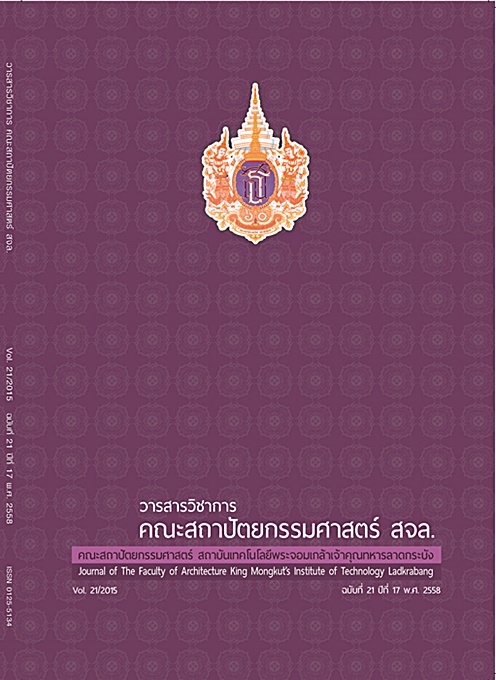คุณค่าที่สมดุลกับการเปลี่ยนแปลงเชิงสัณฐานของเรือนค้าขายพื้นถิ่น ในตลาดริมน้ำดอนหวาย ลุ่มน้ำนครชัยศรี นครปฐม (The Balanced Value of the Morphological Transformation of the Vernacular Trading Houses at Don Wai Waterfront Market, Nakhon Chaisi River, Nakhon)
Main Article Content
Abstract
บทคัดย่อ
บทความนี้เป็นการวิเคราะห์การเปลี่ยนแปลงเชิงสัณฐานของเรือนค้าขายพื้นถิ่น ในตลาดริมน้ำดอนหวาย จังหวัด
นครปฐม ร่วมกับการให้ความหมายตามทฤษฎีการสร้างคุณค่า เสนอโดย Tsunesaburo Makiguchi (1871-1944) และแนวคิดระบบคุณค่า โดย Laurence G. Boldt (2009) และ Bernard Feilden (2003) สามารถเทียบเคียงระดับคุณค่าได้ 3 ประการคือ “ประโยชน์ ความงาม ความดี” โดยพบว่า องค์ประกอบเชิงสัณฐานของเรือนค้าขายพื้นถิ่น ประกอบด้วยลักษณะรูปร่าง รูปทรงและรูปแบบอาคาร พื้นที่ว่างภายในและภายนอกอาคาร สภาพแวดล้อม รูปแบบการใช้สอย รวมทั้ง รูปแบบกิจกรรมการค้า มีการเปลี่ยนแปลงในทุกองค์ประกอบ โดยเป็นไปเพื่อรองรับกิจกรรมการค้าเชิงท่องเที่ยว ซึ่งเป็นคุณค่าเชิง “ประโยชน์” เพียงประการเดียว โดยไม่ได้คำนึงถึงคุณค่าเชิง “ความงาม” ที่เป็นการรักษาเอกลักษณ์ด้านสัณฐานไว้ ส่งผลให้คุณค่าเชิง “ความดี” ที่เป็นความรู้สึกหวงแหนและอยากอนุรักษ์ให้ดำรงอยู่สืบไปไม่อาจเกิดขึ้นได้ จากการศึกษาจึงมีข้อเสนอแนะว่าต้องประสานคุณค่าให้เกิดขึ้นทั้ง 3 ประการ กล่าวคือ (1) คุณค่าเชิงประโยชน์ ต้องสามารถรองรับการใช้งานได้อย่างเหมาะสมกับกิจกรรมการค้าในบริบทปัจจุบัน (2) คุณค่าเชิงความงาม ต้องรักษาเอกลักษณ์เชิงสัณฐานของอาคารได้ครบทุกองค์ประกอบ (3) คุณค่าเชิงความดี ต้องเกิดความตระหนักในการปกป้องรักษาเรือนค้าขายพื้นถิ่นเพื่อส่งต่อแก่คนรุ่นหลัง กระบวนการสร้างคุณค่าที่เกิดขึ้นจึงจะมีความยั่งยืน เพื่อให้สถาปัตยกรรมพื้นถิ่นในตลาดริมน้ำแห่งนี้ สามารถดำรงได้อยู่ภายใต้กระแสการท่องเที่ยวปัจจุบัน
คำสำคัญ: การเปลี่ยนแปลงเชิงสัณฐาน เรือนค้าขายพื้นถิ่น ตลาดริมน้ำดอนหวาย ทฤษฎีระบบคุณค่า
Abstract
This article analyzes the morphological transformation of the vernacular trading houses at Don Wai waterfront market in Nakhon Pathom Province and interprets the value creation based on Tsunesaburo Makiguchi’s Theory of Value System (1871-1944) and the value system theories proposed by Laurence G. Boldt (2009) and Bernard Feilden (2003). The values can be classified into three types: utility, aesthetics and virtue. The components of the morphology of the vernacular trading houses are shapes, forms and patterns of the building,
the interior and exterior space, the surroundings, the functional patterns and the types of trading activities.All of these components have been transformed to support tourism trading activities which are characterized as the utility value. The transformation does not take the aesthetic value into consideration and this value plays a part in preserving the vernacular uniqueness of a building, resulting in the disappearance of the virtue value in terms of willingness to protect and preserve a building. According to the findings, it is suggested thatthe three values should be highlighted in that (1) the utility value should be in line with current trading activities, (2) the aesthetic value should help preserve every aspect of the vernacular uniqueness of each building, and (3) the virtue value should promote awareness among the residents in that they should preserve their traditional trading houses so that their descendants can appreciate such architecture. With these three values, the process of value creation can be sustainable; as a result, the architecture of the trading houses on the waterfront can survive current tourism trends.
Keywords: Morphological Transformation Vernacular Trading Houses Don Wai Waterfront Market The Theory of Value System
Article Details
This work is licensed under a Creative Commons Attribution-NonCommercial-ShareAlike 4.0 International License.
Copyright Transfer Statement
The copyright of this article is transferred to Journal of The Faculty of Architecture King Mongkut's Institute of Technology Ladkrabang with effect if and when the article is accepted for publication. The copyright transfer covers the exclusive right to reproduce and distribute the article, including reprints, translations, photographic reproductions, electronic form (offline, online) or any other reproductions of similar nature.
The author warrants that this contribution is original and that he/she has full power to make this grant. The author signs for and accepts responsibility for releasing this material on behalf of any and all co-authors.


